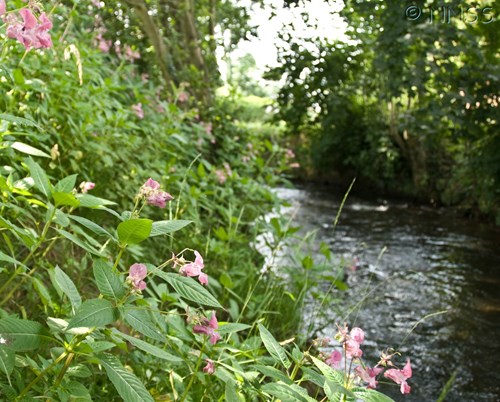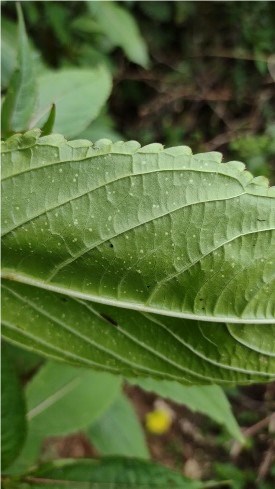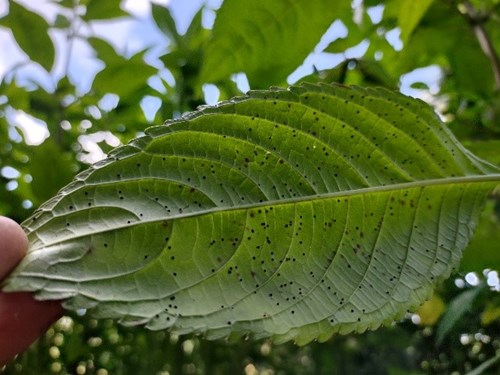Using science to tackle invasive species

The Four Rivers for LIFE project aims to reduce the impact of Invasive Non-Native Species (INNS) such as Himalayan balsam, American skunk cabbage, Japanese knotweed and Giant hogweed within the catchments of the rivers: Teifi, Tywi, Cleddau and Usk in south Wales.
Here, Four Rivers for LIFE Senior River Restoration Officer, Leila Thornton talks about the project’s INNS work and the innovative method they are trialling to control Himalayan balsam in particular.
What is INNS?
INNS is any non-native animal or plant that can spread, causing damage to our natural resources, environment, the economy, our health and the way we live.
There are currently more than 350 invasive non-native species of interest to Wales - some of which are yet to arrive and others which are already present. .
There are approximately 150 INNS present in Wales, you can check the list of INNS and their distribution on the Wales INNS portal.
Why are INNS a problem?
All four rivers that form part of the Four Rivers for LIFE project (the Teifi, Tywi, Cleddau and Usk) have records of INNS such as Himalayan balsam, American skunk cabbage, Japanese knotweed and Giant hogweed in their vicinity. Controlling the spread and the impact of these plants is a key aim for the project.
Himalayan balsam (Impatiens glandulifera) is an INNS that has become widespread in the UK, colonising riverbanks, riparian margins and wet woodlands.

Himalayan balsam above, credit GB NNSS
It competes with native plant species for space, light, nutrients and pollinators, excluding other plant growth and, as a result, reduces native biodiversity.
Himalayan balsam dies back during winter months, leaving riverbanks bare of vegetation and making them prone to erosion. These combined impacts lead to habitat degradation and reduced ecosystem resilience.
Traditional control techniques for Himalayan balsam (namely cutting, pulling and spraying) can be effective in achieving localised control, but managing it for widespread and lasting eradication can be challenging.
This is why the Four Rivers for LIFE Project is looking to test an innovative technique to add to its toolbox for managing Himalayan Balsam over the long-term.
How science is tackling the invaders
The project is working closely with the Centre for Agriculture and Bioscience International ( CABI ) to trial a biological control agent for Himalayan Balsam.
CABI has been assessing the effectiveness of a rust fungus (Puccinia komarovii var. glanduliferae), native to the Himalayas, as a potential control option.
The rust is a fungus that infects the stem and leaves of Himalayan balsam throughout the growing season.
Extensive laboratory testing has shown that rust fungus can be effective in reducing the cover of Himalayan balsam and that it does not negatively impact any other native plant species.
In 2014, DEFRA approved the rust fungus for field release. To date, two strains of the rust have been released in the UK; one from India and one from Pakistan.
While the rust fungus was effective in infecting plants at some sites, treatment has been unsuccessful at other locations. It is thought that this is partly due to differences in environmental conditions such as shading, humidity and flood regime, between sites.
Further experimental field trials are needed to identify the factors determining the success of rust fungus, and to develop its use as a potential control tool.
This is where the Four Rivers for LIFE Project was able to help as it represented an excellent opportunity to undertake further testing.
How does treatment work?
The Project Team and fellow Natural Resources Wales (NRW) officers are working with colleagues from Bannau Brycheiniog to identify eight potential treatment sites across the Teifi, Tywi, Cleddau and Usk catchments, following the criteria recommended by CABI.
The criteria requires an area around 10x10 metres where dense Himalayan balsam exists. It also requires the area to be un-grazed, unshaded, humid and unlikely to be disturbed by flooding or human activity.
Not all Himalayan Balsam populations in the UK are susceptible to the rust. Therefore, before new sites are accepted into CABI’s release programme, the susceptibility of plants from these sites needs to be tested under natural and laboratory conditions.
Himalayan balsam seeds were collected from eight sites across four catchments during 2022 and submitted to CABI for susceptibility testing.
Of the eight sites tested in 2022, six showed susceptibility to the two available strains of rust fungus and were therefore accepted as suitable trial sites.
These include two sites on the main River Usk, one site on the main River Tywi and one on the Gwili (a tributary of the Tywi), and two sites on tributaries of the Teifi (the Hirwaun and the Cych).
Rust fungus was released at these six sites during summer 2023. Rust spores were applied three times over the growing season (June, July, August) in order to maximise the spore levels at each site.
During each inoculation, the rust fungus is mixed with water and sprayed onto the underside of the leaves of the plant, as the underside is more susceptible. It takes a few weeks for the rust fungus to take hold.
Monitoring visits were then carried out around 4-6 weeks after each inoculation to record the number of infected plants and the distance that the rust had spread, and the data was submitted to CABI for analysis. A further monitoring visit will be carried out in spring 2024 to make an assessment of overwintering rust infection at these six sites.
Initial results have shown evidence of leaf chlorosis at all sites (see images below). These images show Himalayan balsam at Green Dinas Estate near Brecon, showing rust fungus as brown and white dots.


What happens next?
Since no suitable trial sites were identified in the Cleddau catchments during 2022, the Four Rivers for LIFE project will be submitting seed from two additional sites for testing during winter 2023.
The proposed sites are on the upper Eastern Cleddau and a site on a tributary of the Western Cleddau (Cartlett Brook).
Results of susceptibility testing at these sites will be available in spring 2024 and further rust inoculations will be carried out in summer 2024 if these sites are accepted as further trial sites.
The Project will continue to monitor the development of the rust fungus at all trial sites in years three to five to record the spread and extent of the rust fungus’ impact.
Alongside the rust trials work, the project will also be delivering targeted management of Himalayan Balsam, Japanese Knotweed, Giant Hogweed and American Skunk Cabbage at strategic locations across the four river catchments.
To keep up to date with our work you can follow us on as Facebook, Twitter and Instagram or subscribe to our newsletter here
